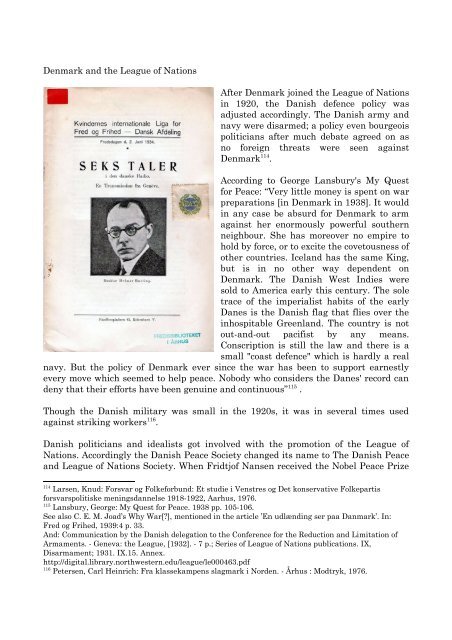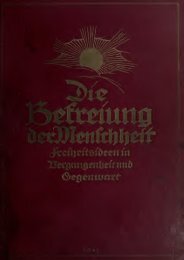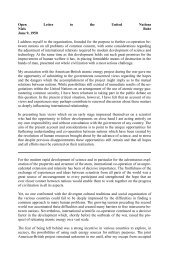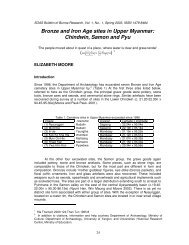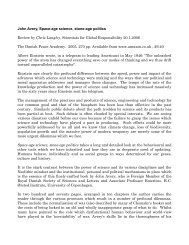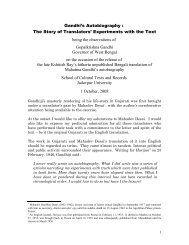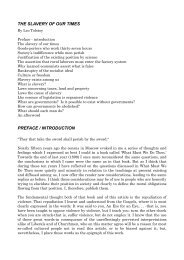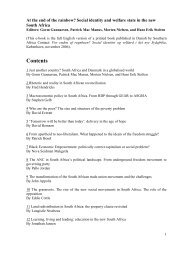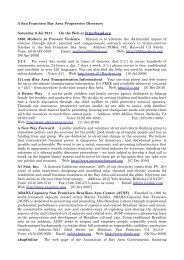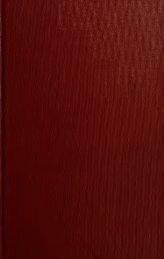Terp, Holger: Danish Peace History - Det danske Fredsakademi
Terp, Holger: Danish Peace History - Det danske Fredsakademi
Terp, Holger: Danish Peace History - Det danske Fredsakademi
Create successful ePaper yourself
Turn your PDF publications into a flip-book with our unique Google optimized e-Paper software.
Denmark and the League of Nations<br />
After Denmark joined the League of Nations<br />
in 1920, the <strong>Danish</strong> defence policy was<br />
adjusted accordingly. The <strong>Danish</strong> army and<br />
navy were disarmed; a policy even bourgeois<br />
politicians after much debate agreed on as<br />
no foreign threats were seen against<br />
Denmark 114 .<br />
According to George Lansbury's My Quest<br />
for <strong>Peace</strong>: “Very little money is spent on war<br />
preparations [in Denmark in 1938]. It would<br />
in any case be absurd for Denmark to arm<br />
against her enormously powerful southern<br />
neighbour. She has moreover no empire to<br />
hold by force, or to excite the covetousness of<br />
other countries. Iceland has the same King,<br />
but is in no other way dependent on<br />
Denmark. The <strong>Danish</strong> West Indies were<br />
sold to America early this century. The sole<br />
trace of the imperialist habits of the early<br />
Danes is the <strong>Danish</strong> flag that flies over the<br />
inhospitable Greenland. The country is not<br />
out-and-out pacifist by any means.<br />
Conscription is still the law and there is a<br />
small "coast defence" which is hardly a real<br />
navy. But the policy of Denmark ever since the war has been to support earnestly<br />
every move which seemed to help peace. Nobody who considers the Danes' record can<br />
deny that their efforts have been genuine and continuous” 115 .<br />
Though the <strong>Danish</strong> military was small in the 1920s, it was in several times used<br />
against striking workers 116 .<br />
<strong>Danish</strong> politicians and idealists got involved with the promotion of the League of<br />
Nations. Accordingly the <strong>Danish</strong> <strong>Peace</strong> Society changed its name to The <strong>Danish</strong> <strong>Peace</strong><br />
and League of Nations Society. When Fridtjof Nansen received the Nobel <strong>Peace</strong> Prize<br />
114 Larsen, Knud: Forsvar og Folkeforbund: Et studie i Venstres og <strong>Det</strong> konservative Folkepartis<br />
forsvarspolitiske meningsdannelse 1918-1922, Aarhus, 1976.<br />
115 Lansbury, George: My Quest for <strong>Peace</strong>. 1938 pp. 105-106.<br />
See also C. E. M. Joad’s Why War[?], mentioned in the article ’En udlænding ser paa Danmark’. In:<br />
Fred og Frihed, 1939:4 p. 33.<br />
And: Communication by the <strong>Danish</strong> delegation to the Conference for the Reduction and Limitation of<br />
Armaments. - Geneva: the League, [1932]. - 7 p.; Series of League of Nations publications. IX,<br />
Disarmament; 1931. IX.15. Annex.<br />
http://digital.library.northwestern.edu/league/le000463.pdf<br />
116 Petersen, Carl Heinrich: Fra klassekampens slagmark i Norden. - Århus : Modtryk, 1976.


